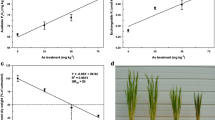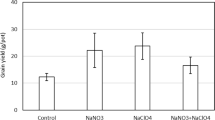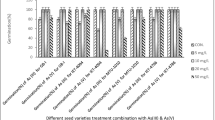Abstract
Arsenic absorption by rice (Oryza sativa, L.) in relation to the chemical form and concentration of arsenic added in nutrient solution was examined. A 4 × 3 × 2 factorial experiment was conducted with treatments consisting of four arsenic chemical forms [arsenite, As(III); arsenate, As(V); monomethyl arsenic acid, MMAA; and dimethyl arsenic acid, DMAA], three arsenic concentrations [0.05, 0.2, and 0.8 mg As L-1], and two cultivars [Lemont and Mercury] with a different degree of susceptibility to straighthead, a physiological disease attributed to arsenic toxicity. Two controls, one for each cultivar, were also included. Arsenic phytoavailability and phytotoxicity are determined primarily by the arsenic chemical form present. Application of DMAA increased total dry matter production. While application of As(V) did not affect plant growth, both As(III) and MMAA were phytotoxic to rice. Availability of arsenic to rice followed the trend: DMAA<As(V)<MMAA<As(III). Upon absorption, DMAA was readily translocated to the shoot. Arsenic(III), As(V), and MMAA accumulated in the roots. With increased arsenic application rates the arsenic shoot/root concentration decreased for the As(III) and As(V) treatments. Monomethyl arsenic acid (MMAA), however, was translocated to the shoot upon increased application. The observed differential absorption and translocation of arsenic chemical forms by rice is possibly responsible for the straighthead disorder attributed to arsenic.
Similar content being viewed by others
References
Atkins J G 1974 Straighthead. In Rice Diseases of the Americas: A Review of Literature. USDA Agric. Handbook 448, pp 58–63.
Atkins J G 1975 Controlling diseases of rice. In Six Decades of Rice Research in Texas. Res. Monograph 4, pp 58–68.
Baker R S, Barrentine W L, Bowman D H, Hawthorne W L and Pettiet J V 1976 Crop response and arsenic uptake following soil incorporation of MSMA. Weed Sci. 24, 322–326.
Bollich C N, Webb B D, Marchetti M A and Scott J E 1985 Registration of ‘Lemont’ rice. Crop Sci. 25, 883–885.
Brannon J M 1983 The Transformation, Fixation, and Mobilization of Arsenic and Antimony in Contaminated Sediments. Ph.D. diss., Louisiana State University, Baton Rouge, LA.
Clements H F and Munson J 1974 Arsenic toxicity studies in soil and in culture solution. Pacific Sci. 1, 151–171.
Deuel L E and Swoboda A R 1972 Arsenic toxicity to cotton and soybeans. J. Environ. Quality 1, 317–320.
Dickens R and Hiltbold A E 1967 Movement and persistence of methanearsenate in soils. Weeds 15, 299–304.
Ferguson J F and Gavis J 1972 A review of the arsenic cycle in natural waters. Water Res. 6, 1259–1274.
Gilmour J T and Wells B R 1980 Residual effects of MSMA on sterility in rice cultivars. Agron. J. 72, 1066–1067.
Jacobs L W, Keeney D R and Walsh L M 1970 Arsenic residue toxicity to vegetable crops grown on plainfield sand. Agron. J. 62, 588–591.
Johnson L R and Hiltbold A E 1969 Arsenic content of soil and crops following use of methanearsenate herbicides. Soil Sci. Soc. Am. Proc. 33, 279–282.
Johnson T H, Cralley E M and Henry S E 1959. Straighthead and rice varieties in Arkansas. Arkansas Farm Research 8, 2.
Jugsujinda A 1976 Growth and Nutrient Uptake by Rice under Controlled Oxidation-reduction and pH Conditions in a Flooded Soil. Ph.D. diss., Louisiana State University, Baton Rouge, LA.
Khattak R A, Page A L, Parker D R and Bakhtar D 1991 Accumulation and interactions of arsenic, selenium, molybdenum and phosphorus in alfalfa. J. Environ. Qual. 20, 165–168.
Liebig G F 1966 Arsenic. In Diagnostic Criteria for Plants and Soils. Ed. H DChapman, pp 14–65. University of California, Riverside, CA.
Machlis L 1941 Accumulation of arsenic in shoots of sudan-grass and bushbean. Plant Physiol. 16, 521–543.
Marin A R 1989 Effect of applications of arsenic and zinc on straighthead disease in rice (Oryza sativa L.). M.Sc. Thesis, Louisiana State University, Baton Rouge, LA.
Masscheleyn P H, Delaune R D and Patrick W HJr 1991a. Arsenic speciation and solubility in a contaminated soil. Environ. Sci. Technol. 25, 1414–1419.
Masscheleyn P.H, Delaune R D and Patrick W HJr 1991b. A hydride generation atomic absorption technique for arsenic speciation. J. Environ. Qual. 20, 96–100.
McKenzie K S, Bollich P K, Linscombe S D, Groth D E, Robinson J F, Jodary F, White L M, Milar M R and Hollier C A 1988 Mercury, an early maturing semidwarf medium-grain rice variety. Louisiana Agric. Exp. Station. Circular #127.
National Academy of Sciences 1977 Arsenic. The National Research Council. Washington, DC. 322 p.
Peoples S A 1975 Review of arsenical pesticides. In Arsenical Pesticides. Ed. A A Woolson. Am. Chem. Soc. Symp. Ser. 7, 1–12.
Reed J F and Sturgis M B 1936 Toxicity from arsenic compounds to rice on flooded soils. J. Am. Soc. Agron. 28, 432–436.
Rumburg C B, Engel R E and Meggitt W F 1960 Effect of phosphorus concentration on the absorption of arsenate by oats from nutrient solution. Agron. J. 52, 452–453.
Schweizer E E 1967 Toxicity of DSMA soil residues to cotton and rotational crops. Weeds 15, 72–76.
Statistical Analysis System 1987 SAS/STAT User's Guide for Personal Computers. SAS Institute Inc., Cary, NC.
Tsusumi M and Takahashi S 1974 Studies on phytotoxicity of arsenic. 1. Inhibitory effect of arsenic salts on growth of rice. Bull. Coll. Agr. Utsun Univ. 9, 87–93.
US Department of Agriculture 1980 The biologic and economic assessment of pentachlorophenol, inorganic arsenicals, creosote. Vol. I: Wood Preservatives. Techn. Bull. 1658-I.
VonEndt D W, Kearney P C and Kaufman D D 1968 Degradation of monosodiumarsenic acid by soil microorganisms. J. Agric. Food Chem. 16, 17–20.
Walsh L M and Keeney D R 1975 Behavior and phytotoxicity of inorganic arsenicals in soils. In Arsenical Pesticides. Ed. E A Woolson. Am. Chem. Soc. Symp. Ser. 7, 35–52.
Wells B R and Gilmour J T 1977 Sterility in rice cultivars as influenced by MSMA rate and water management. Agron. J. 69, 451–454.
Woolson E A, Axley J H and Kearney P C 1971a Correlation between available soil arsenic, estimated by six methods, and response of corn (Zea mays L.). Soil Sci. Soc. Am. Proc. 35, 101–105.
Woolson E A, Axley J H and Kearney P C 1971b The chemistry and phytotoxicity of arsenic in soils. I. Contaminated field soils. Soil Sci. Soc. Am. Proc. 35, 938–943.
Woolson E A, Axley J H and Kearney P C 1973 The chemistry and phytotoxicity of arsenic in soils. II. Effects of time and phosphorus. Soil Sci. Soc. Am. Proc. 37, 254–259.
Yoshida S, Forno D A, Cook J H and Gomez K A 1976 Laboratory Manual for Physiological Studies of Rice, 3rd ed. International Rice Research Institute, Los Baños, Philippines.
Author information
Authors and Affiliations
Rights and permissions
About this article
Cite this article
Marin, A.R., Masscheleyn, P.H. & Patrick, W.H. The influence of chemical form and concentration of arsenic on rice growth and tissue arsenic concentration. Plant Soil 139, 175–183 (1992). https://doi.org/10.1007/BF00009308
Received:
Issue Date:
DOI: https://doi.org/10.1007/BF00009308




